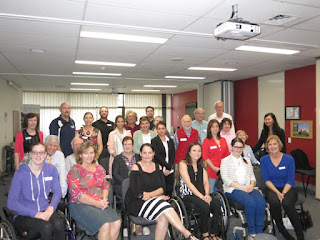I have a very rare disease, Transverse Myelitis, which affects 1-8 in a million people. I contracted it in July 2008 immediately following my return from a holiday in Europe. I don't know how it happened though I endured numerous tests to rule out many other illnesses including HIV, syphilis and Lyme Disease. Therefore I have Idiopathic Transverse Myelitis which basically means no one knows why this happened. TM is an autoimmune disease so something, perhaps a virus or bacteria entered my body and my immune system thought my spinal cord was being attacked leaving the myelin sheath (the outer coating which covers my spinal cord) exposed. The commands from my brain to my lower extremities were partially blocked at T7, just above my waist. Therefore, I am a T7 incomplete paraplegic. All this was not immediately apparent. It took about three months to get that far. In the mean time, my legs gradually became weaker. I could no longer run or even walk properly. I was holding on to bannisters, leaning against poles, using shopping trolleys like a wheelie-walker before I was hospitalised after I could no longer feel the pedals to drive the car. After tests, I was treated with intravenous steroids. Further hospital stays involved more intravenous drugs, but little or no exercise so returned home weaker. This disease, likely due to its rarity, is difficult to diagnose, particularly when no lesion is shown on an MRI. Each TM patient has a different presentation of the disease. Some have one attack and recover in a short time. Some, like me, are left with permanent damage.
I joined the Transverse Myelitis Association, based in USA which has the most information about this disease. They also have a YouTube channel here. One of the things they emphasise repeatedly is the importance of exercise. I was very fortunate to discover the Sporting Wheelies & Disabled Association gym. I began an exercise program there while being on the waiting list to commence the Walk On program (now called NeuroMoves). I began that in 2011. Walk On in Australia is run by Spinal Cord Injuries Australia (SCIA) and is based on the Project Walk program in the USA. It involves two hour sessions of intensive repetitive exercises. Initially I attended two or three times a week until I had reached the limit of my potential. Now I have a one hour Personal Training session (weights and aerobic) and one Walk On session each week with an Exercise Physiologist. I practise standing, work on core strength and practise walking on a treadmill while in a harness. The cumulative effect of this exercise has been greater strength and, most importantly confidence to take care of myself.
 |
| TM Day in Brisbane, May 2015 |
What do all these organisations have in common, apart from their desire to help people who have a spinal cord injury, including TM? They are all not-for-profit so rely on fundraising and grants to maintain their services. They all do a great job.


